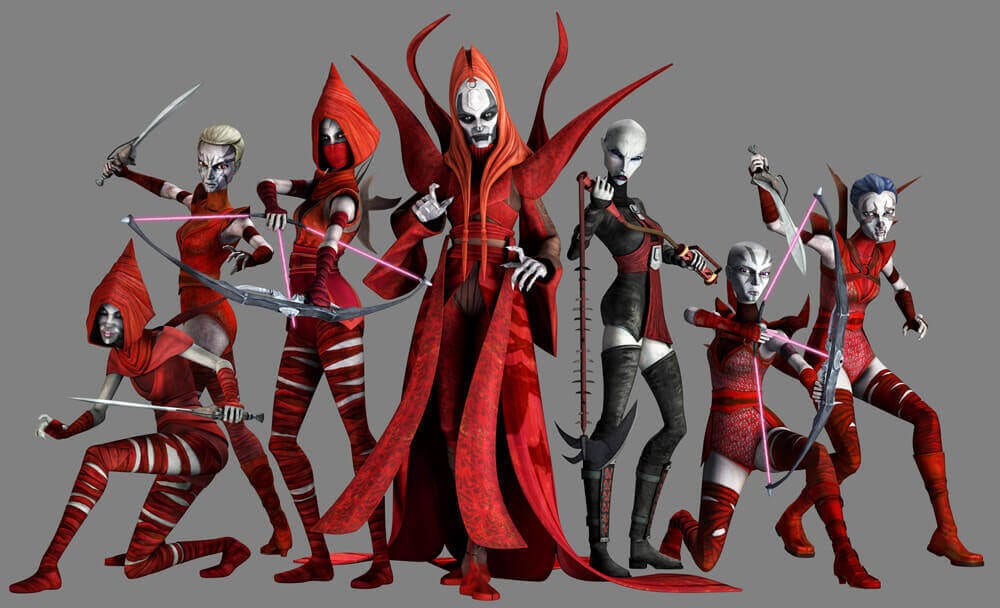The Women of Star Wars: Asajj Ventress, Mother Talzin and the Nightsisters
The Clone Wars series, which ran from 2008 to 2014 (and is being revived on Disney+ later this month), lent itself to the expansion of characters and concepts introduced in the prequel trilogy. Naturally, this included the trilogy’s lead female character, Padmé Amidala, as well as those who were essentially background cameos in the films, such as Jedi Knights Aayla Secura, Shaak Ti, and Luminara Unduli. And, of course, I would be totally remiss if I neglected to mention the series’ original characters, including Ahsoka Tano, Padawan to Anakin Skywalker during the Clone Wars. All of these characters have been or will be discussed here at one time or another, but today I’d like to take a look at the Nightsisters.

Among The Clone Wars’ highlights are the story arcs focusing on Dathomir, Darth Maul’s planet of origin. These storylines introduce us to the Nightsisters, a coven of witches native to the planet. They were originally introduced in the 1994 EU novel The Courtship of Princess Leia, and while I have yet to read that story, I’m glad they were included in The Clone Wars. They’re roped into the show’s narrative thanks to Asajj Ventress, Count Dooku’s fallen apprentice, who was initially created for Genndy Tarkovsky’s 2003 Clone Wars series. There, she was merely an aspiring Sith voiced by Grey DeLisle, who also voiced Padmé, Shaak Ti, and others on the show, and would go on to voice Princess Azula on Avatar: The Last Airbender, among numerous other roles.
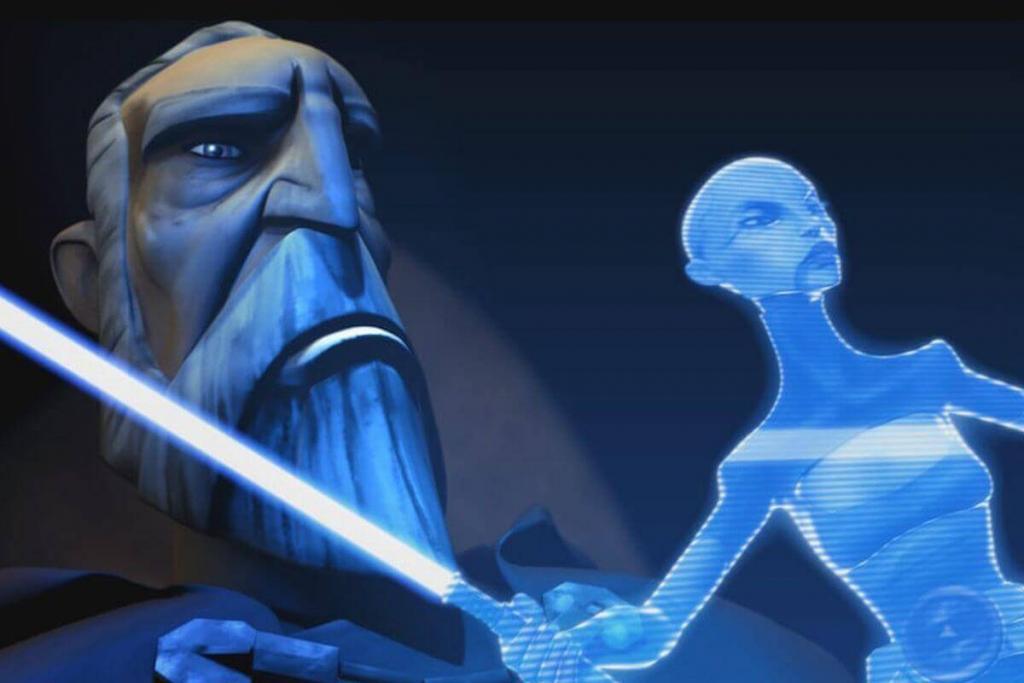
However, having a longer running time per episode and more episodes overall, Dave Filoni’s 2008 Clone Wars would map out a much larger, more complex arc for this character. In this series, she is played by Nika Futterman, who voiced Smellerbee on A:TLA. Truth be told, Asajj is one of my favorite Star Wars characters. Much has been said about Ahsoka’s incredible transformation over the animated Star Wars shows, and I can’t wait to talk about her next time. Asajj is, in many ways, similar to Ahsoka, and their destinies almost seem linked, and yet she never gets the attention and appreciation enjoyed by her Light Side counterpart. Both women start this series as apprentices and are largely shaped by their relationships to their respective masters. Both fall in love with someone from “the other side” of the war, both are orphans, both learn and are forced to make difficult choices, and both prove to be much more than the surface would suggest. They even both wield dual sabers at one point or another. Whether or not you consider the 2003 Clone Wars micro-series, Asajj is introduced as Count Dooku’s apprentice, who longs to be a Sith Lord. Of course, “always two there are; no more, no less,” and as such, Asajj is treated more as Dooku’s personal gofer. It’s easy to hate Ventress at first; everything from her voice to her design to her actual interactions with other characters is designed to elicit anger at her successes and joy at her every failing. She’s constantly trying to ingratiate herself with her Master by killing characters we love (Annakin, Obi-Wan, and Ahsoka) as well as those we feel sorry for (King Katuunko in season 1, episode 1, “Ambush,” and Master Luminara Unduli in season 1, episode 9, “Cloak of Darkness.”) She also commits sadistic acts that aren’t necessary to her goals, like kissing Commander Colt as she puts her lightsaber through him (Season 3, Episode 2, “ARC Troopers”). Overall, she’s a horrible person and seemingly wants to watch the world burn for no particular reason.
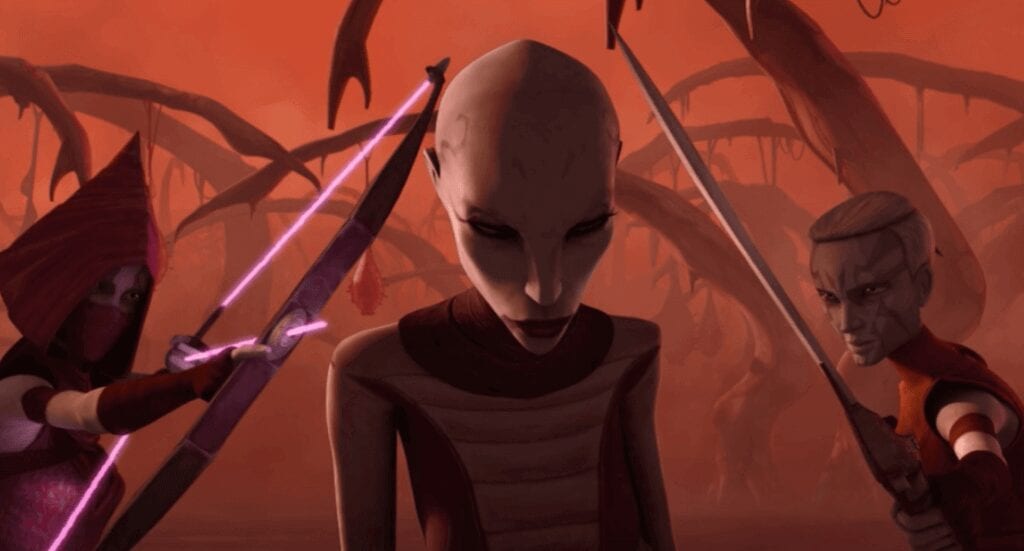
However, Asajj’s story takes a fascinating turn in season 3, episode 12, “Nightsisters.” Sensing Ventress’ increasing power, Darth Sidious begins to see her as a threat, fearing that Dooku intends to make her his Sith apprentice and kill him. Unsurprisingly, Sidious orders Dooku to kill Ventress as a sign of loyalty and obedience. Count Dooku bombs a ship on which Ventress is doing battle with Anakin Skywalker and Obi-Wan Kenobi; the Jedi flee on their own craft, and Ventress is presumed dead, barely escaping with her life. Her sheer will to survive takes her to Dathomir, her homeworld from which she was stolen as a child.

There she seeks solace with the Nightsisters and receives aid from their leader, Mother Talzin (Barbara Dale Goodson). Talzin treats the physical wounds from the confrontation and subsequent escape, and throughout this process, we get bits and pieces of Asajj’s backstory. A criminal named Hal’Sted was the one to take her from her ancestral home to use her as a slave. He was killed by pirates, and when the Jedi Ky Narec was almost similarly dispatched, Asajj accidentally used the Force to push the pirate away from him. This led him to take her as his Padawan. Under his teaching, she flourished for a decade, until he was ultimately killed in combat. Ventress had been repeatedly orphaned and isolated, this particular instance serving as a catalyst for her fall to the Dark Side of the Force. She ended up ruling over the planet on which she had formerly been a slave and then a Jedi apprentice. Her power was eventually enough to attract Count Dooku’s attention, and the rest is history. Asajj was eager enough to kill Jedi under her dark Master’s command, in part because she blamed them as much for Narec’s death as the pirate who killed him. This ultimate betrayal by Dooku is yet another turning point in Ventress’s life, forcing her to find a new path without a master to follow.
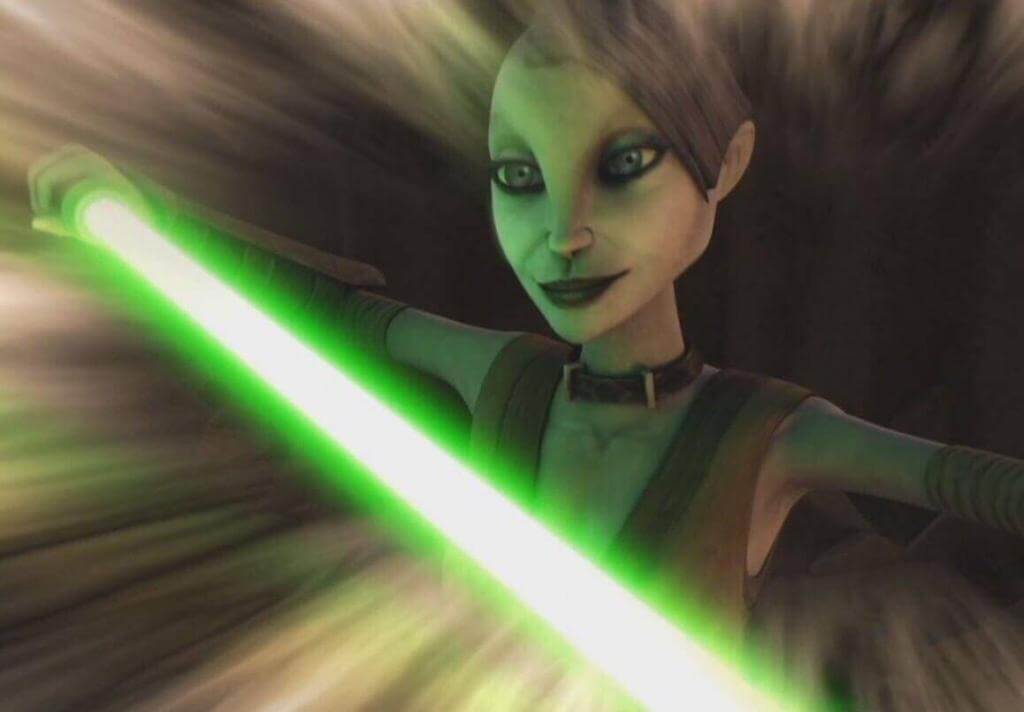
Naturally, the angry young woman chooses revenge, and Mother Talzin is all too eager to help, although not for entirely altruistic reasons. Asajj tests the Nightbrothers – Dathomirian males kept as servants, mates, and whatever the Nightsisters may need – to find the perfect champion against Dooku. In yet another unnecessarily sadistic twist, after identifying Savage Opress as the perfect killing machine and getting him under Talzin’s control, Ventress orders him to murder his weaker brother whom he had been protecting throughout her trials. Personally, as they were exploring a more nuanced, sympathetic side to Asajj’s character, this really shocked me, and I was actually angry when it happened. So wrong on so many levels. Regardless, Mother Talzin sends Savage to Dooku under the guise of a new apprentice to replace his “lost” assassin, Ventress. At first, the ruse plays out perfectly, with Dooku pleased enough and Asajj having an ally on the inside. Asajj and her creation coordinate and attempt assassination of the Count, but even together, the two Dathomirians are no match for the great Lord of the Sith. Savage breaks free of Ventress and Talzin’s control, refusing to obey the former’s commands any longer. Eventually Asajj ends up back on Dathomir, and this time she pledges herself to the Nightsisters as a full member. Sadly, this reunion doesn’t last long, as General Grievous and his droids soon massacre the Coven on Dooku’s orders. Mother Talzin and Old Daka’s Magicks, the latter of which literally raises the planet’s dead Nightsisters, can’t hold off all of the droids. All are killed save for Mother Talzin and Asajj, and the former tells the latter that, while her destiny will always be tied to that of her sisters, she must again strike out and find her own way.
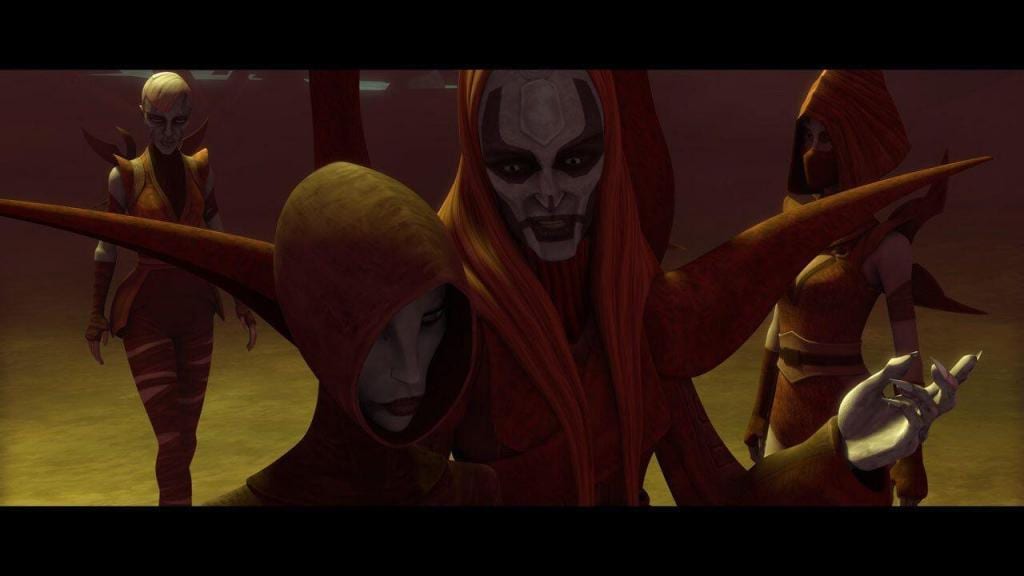
This was another devastating loss for Asajj. She then joins with Boba Fett, Bossk, and their ragtag team of bounty hunters to replace a member she killed. They’re tasked with protecting a priceless chest from a group of bandits as it’s transported to a King who will pay handsomely. Slowly, the bandits take out all of the hunters save for Boba and Asajj, and soon the fallen apprentice discovers that it’s not mere jewels in the chest: it’s a little girl, a child bride for the King. The “bandits” are really rescuers led by her older brother. At first, Asajj plays it cool, insisting that this is a job like any other, and she doesn’t care about the girl or her situation. However, she wavers when the girl, Pluma, comments that Asajj doesn’t know what it’s like to be taken from your home and family. She replies that she does know what it’s like, and decides to scam the King. She collects the bounty and gives his guards the chest with Boba stuffed in it, returning Pluma to her brother and splitting the reward with her cohorts. The next time we see Ventress, Savage has come up as a bounty wanted by the Republic, and she accepts gladly. She hunts him down and is surprised to find he isn’t alone. Her dark creation has joined together with a mutilated Darth Maul (with legs and mind restored by Talzin, his biological mother.) She finds the two beating Obi-Wan mercilessly, seeking to exact Maul’s terrible vengeance. The strange workings of fate have led Asajj to fight alongside her former enemy, even protecting him from Maul’s blows and distracting the two Nightbrothers when possible. Ultimately, Obi-Wan and Ventress are no match for the rage and darkness at play and must flee.

In season 5, Asajj is still working as a bounty hunter when she makes yet another shocking decision. She tracks down Ahsoka Tano, now on the run from the Jedi, who have falsely accused her of murder. However, when she finds her target, rather than killing her or turning her in, she believes in Ahsoka’s innocence. She actually helps her find the truth in the matter. Not only was her former enemy innocent, but she was framed by Barriss Offee, Padawan learner of Master Luminara Unduli and Ahsoka’s supposed friend. This profitless, selfless venture wouldn’t be Ventress’ final surprise, either. There was a story arc planned for The Clone Wars that would have paired Asajj with the Jedi Master Quinlan Vos on yet another mission to assassinate Count Dooku. These episodes were written but not produced before Disney’s cancellation of the series, so they were converted into the 2015 novel Dark Disciple by Christie Golden. The book has a foreword from George Lucas’ daughter, Katie, who wrote these episodes and several others concerning Asajj and the Nightsisters. Asajj and Quinlan fall in love over the course of this mission. This complicates things, and all does not go according to plan, as Vos is captured and tortured by Dooku. Ventress joins Kenobi and Skywalker to rescue Vos. However, Dooku’s torment of Vos hasn’t been without consequence, and he falls to the Dark Side. Asajj’s love for Quinlan motivates her to jump between him and Dooku, sacrificing her own life for his. Just as Vos played a part in Asajj’s rehabilitation, losing her is enough to make him see the folly of the Dark Side.
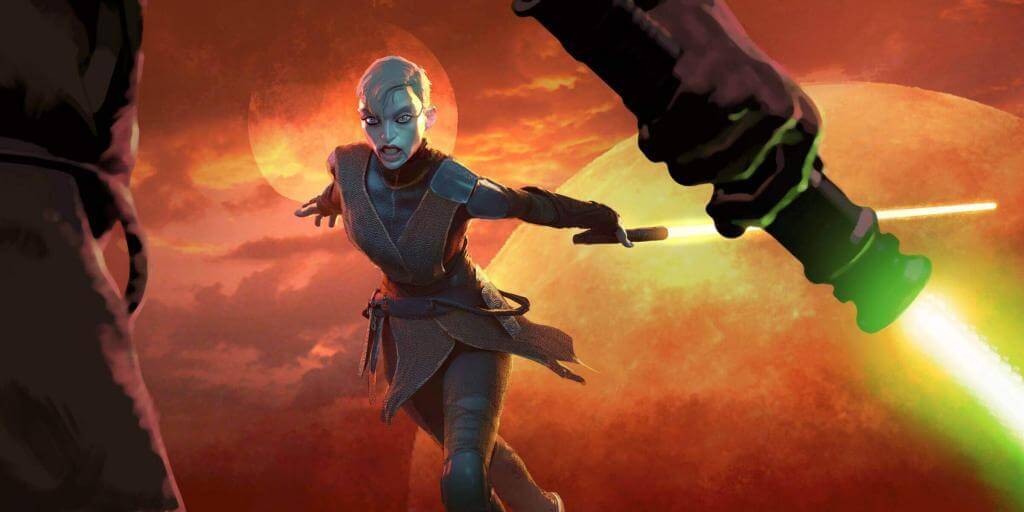
When I first watched The Clone Wars, you couldn’t have told me what an interesting, complex, tragic character Asajj was. Her journey over the course of this TV series (to say nothing of other materials in which she appears) is incredible, and on par with that of Ahsoka, her enemy with whom she shares so much. In fact, if Asajj hadn’t had such a traumatic and confusing childhood, one wonders if she would have stayed with the Light. She seemed happiest with the Jedi Master Ky Narec, and it’s implied that his death was the straw that broke the camel’s back. However, it would be cheap and lazy to say that Asajj is a result of her circumstances and nothing more. The Dark and Light sides are always a choice, and Asajj is shown making active choices throughout the series and beyond. Star Wars is about making the right decisions to fulfill your destiny and be the person you want to be. Star Wars is also, at its core, about redemption. If it wasn’t too late for twisted, murderous Darth Vader, it seems only fair that Dooku’s wounded, confused apprentice be granted a second chance. Most importantly, she doesn’t waste it. Once Ventress leaves Dathomir, she’s a changed person, and it’s truly an awesome transformation to behold.

